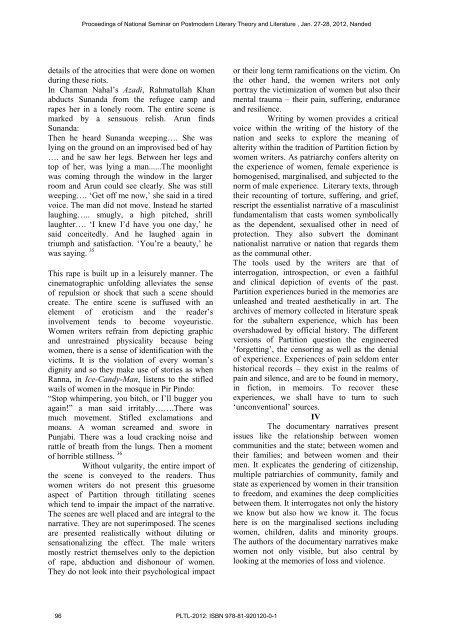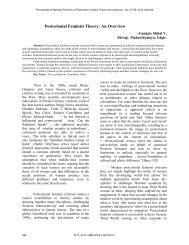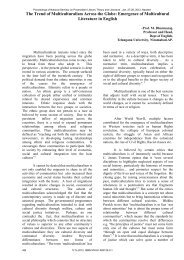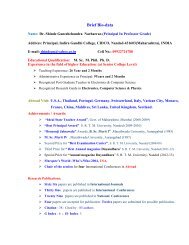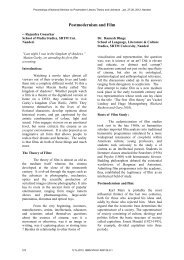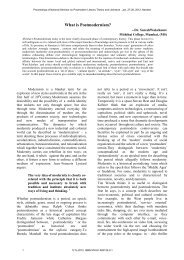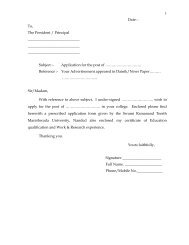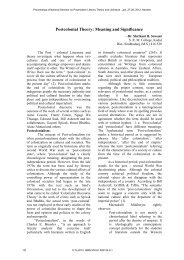Post-Structuralism: An Indian Preview - Igcollege.org
Post-Structuralism: An Indian Preview - Igcollege.org
Post-Structuralism: An Indian Preview - Igcollege.org
You also want an ePaper? Increase the reach of your titles
YUMPU automatically turns print PDFs into web optimized ePapers that Google loves.
Proceedings of National Seminar on <strong>Post</strong>modern Literary Theory and Literature , Jan. 27-28, 2012, Nanded<br />
details of the atrocities that were done on women<br />
during these riots.<br />
In Chaman Nahal’s Azadi, Rahmatullah Khan<br />
abducts Sunanda from the refugee camp and<br />
rapes her in a lonely room. The entire scene is<br />
marked by a sensuous relish. Arun finds<br />
Sunanda:<br />
Then he heard Sunanda weeping…. She was<br />
lying on the ground on an improvised bed of hay<br />
…. and he saw her legs. Between her legs and<br />
top of her, was lying a man......The moonlight<br />
was coming through the window in the larger<br />
room and Arun could see clearly. She was still<br />
weeping…. ‘Get off me now,’ she said in a tired<br />
voice. The man did not move. Instead he started<br />
laughing….. smugly, a high pitched, shrill<br />
laughter…. ‘I knew I’d have you one day,’ he<br />
said conceitedly. <strong>An</strong>d he laughed again in<br />
triumph and satisfaction. ‘You’re a beauty,’ he<br />
was saying. 35<br />
This rape is built up in a leisurely manner. The<br />
cinematographic unfolding alleviates the sense<br />
of repulsion or shock that such a scene should<br />
create. The entire scene is suffused with an<br />
element of eroticism and the reader’s<br />
involvement tends to become voyeuristic.<br />
Women writers refrain from depicting graphic<br />
and unrestrained physicality because being<br />
women, there is a sense of identification with the<br />
victims. It is the violation of every woman’s<br />
dignity and so they make use of stories as when<br />
Ranna, in Ice-Candy-Man, listens to the stifled<br />
wails of women in the mosque in Pir Pindo:<br />
“Stop whimpering, you bitch, or I’ll bugger you<br />
again!” a man said irritably…….There was<br />
much movement. Stifled exclamations and<br />
moans. A woman screamed and swore in<br />
Punjabi. There was a loud cracking noise and<br />
rattle of breath from the lungs. Then a moment<br />
of horrible stillness. 36<br />
Without vulgarity, the entire import of<br />
the scene is conveyed to the readers. Thus<br />
women writers do not present this gruesome<br />
aspect of Partition through titillating scenes<br />
which tend to impair the impact of the narrative.<br />
The scenes are well placed and are integral to the<br />
narrative. They are not superimposed. The scenes<br />
are presented realistically without diluting or<br />
sensationalizing the effect. The male writers<br />
mostly restrict themselves only to the depiction<br />
of rape, abduction and dishonour of women.<br />
They do not look into their psychological impact<br />
or their long term ramifications on the victim. On<br />
the other hand, the women writers not only<br />
portray the victimization of women but also their<br />
mental trauma – their pain, suffering, endurance<br />
and resilience.<br />
Writing by women provides a critical<br />
voice within the writing of the history of the<br />
nation and seeks to explore the meaning of<br />
alterity within the tradition of Partition fiction by<br />
women writers. As patriarchy confers alterity on<br />
the experience of women, female experience is<br />
homogenised, marginalised, and subjected to the<br />
norm of male experience. Literary texts, through<br />
their recounting of torture, suffering, and grief,<br />
rescript the essentialist narrative of a masculinist<br />
fundamentalism that casts women symbolically<br />
as the dependent, sexualised other in need of<br />
protection. They also subvert the dominant<br />
nationalist narrative or nation that regards them<br />
as the communal other.<br />
The tools used by the writers are that of<br />
interrogation, introspection, or even a faithful<br />
and clinical depiction of events of the past.<br />
Partition experiences buried in the memories are<br />
unleashed and treated aesthetically in art. The<br />
archives of memory collected in literature speak<br />
for the subaltern experience, which has been<br />
overshadowed by official history. The different<br />
versions of Partition question the engineered<br />
‘f<strong>org</strong>etting’, the censoring as well as the denial<br />
of experience. Experiences of pain seldom enter<br />
historical records – they exist in the realms of<br />
pain and silence, and are to be found in memory,<br />
in fiction, in memoirs. To recover these<br />
experiences, we shall have to turn to such<br />
‘unconventional’ sources.<br />
IV<br />
The documentary narratives present<br />
issues like the relationship between women<br />
communities and the state; between women and<br />
their families; and between women and their<br />
men. It explicates the gendering of citizenship,<br />
multiple patriarchies of community, family and<br />
state as experienced by women in their transition<br />
to freedom, and examines the deep complicities<br />
between them. It interrogates not only the history<br />
we know but also how we know it. The focus<br />
here is on the marginalised sections including<br />
women, children, dalits and minority groups.<br />
The authors of the documentary narratives make<br />
women not only visible, but also central by<br />
looking at the memories of loss and violence.<br />
96 PLTL-2012: ISBN 978-81-920120-0-1


